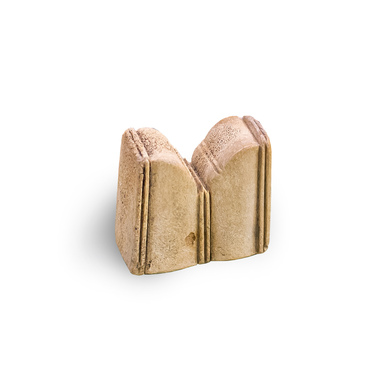The khum was a large pottery vessel to store the food. The word ‘khumcha’ was used for smaller items. The name ‘khum’ comes from an old Iranian word — it meant not only a ready-made vessel for storage but also any pottery prepared for firing. Now khum is common in the Near and Middle East.
Khums were made on a slow spinning potter’s wheel. Normally three pieces were made separately and then pieced together. In this form, they were dried outside the furnace and then were fired. In the bottoms of some khums, even before firing, holes were made with a round stick, so the researchers think that liquid products were not kept in khums. Most likely they were used for storing grain. The hole in the bottom improved air circulation, preventing the grain from getting damp and moldy.
Bolgar potters applied an ornament or simple patterns on the walls before firing the khum.
In Volga Bulgaria, khums were made without a hole in the bottom. Such vessels were used in the house in the following way: foods were put in them, covered with the lid, lowered into a previously prepared hole, and buried in the ground up to the neck. To avoid damaging the khum, it was lowered on a rope threaded through the handles. This method of storing supplies was likely the origin of the word “cellar” (“pogreb” in Russian which comes from “pogrebat”’ —“to bury’). Bulgars stored butter in khums. At the end of August or beginning of September it was churned, and not to make it spoil honey was poured on top. Even our distant ancestors had an idea not only about the healing but also about the preservative properties of this natural product.
In Russia, in the 10th — 12th centuries, there was a vessel similar to khum, called korchaga (also “tagan”). This is an item with a round or sharp bottom, made of clay. Its description also mentions a narrow neck and two vertical handles. As a rule, in peasant homes, there were several korchagas of different sizes. For example, common were containers of half a bucket and two buckets. In such vessels liquids or grain were stored and transported.
Khums were made on a slow spinning potter’s wheel. Normally three pieces were made separately and then pieced together. In this form, they were dried outside the furnace and then were fired. In the bottoms of some khums, even before firing, holes were made with a round stick, so the researchers think that liquid products were not kept in khums. Most likely they were used for storing grain. The hole in the bottom improved air circulation, preventing the grain from getting damp and moldy.
Bolgar potters applied an ornament or simple patterns on the walls before firing the khum.
In Volga Bulgaria, khums were made without a hole in the bottom. Such vessels were used in the house in the following way: foods were put in them, covered with the lid, lowered into a previously prepared hole, and buried in the ground up to the neck. To avoid damaging the khum, it was lowered on a rope threaded through the handles. This method of storing supplies was likely the origin of the word “cellar” (“pogreb” in Russian which comes from “pogrebat”’ —“to bury’). Bulgars stored butter in khums. At the end of August or beginning of September it was churned, and not to make it spoil honey was poured on top. Even our distant ancestors had an idea not only about the healing but also about the preservative properties of this natural product.
In Russia, in the 10th — 12th centuries, there was a vessel similar to khum, called korchaga (also “tagan”). This is an item with a round or sharp bottom, made of clay. Its description also mentions a narrow neck and two vertical handles. As a rule, in peasant homes, there were several korchagas of different sizes. For example, common were containers of half a bucket and two buckets. In such vessels liquids or grain were stored and transported.



